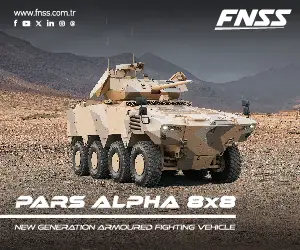AAV / LVTP-7 / AAV-7 / AAVP-7A1
Tracked Assault Amphibious Armored Vehicle - United States

Description
The AAV Assault Amphibious Vehicle is primarily used by the United States Marine Corps (USMC) rather than the Army. AAVs are also commonly called "Amtracs," which is short for "amphibious tractors." The AAV-7A1 is the current model in use and has been in service since the early 1970s. It is designed to transport troops from ships to shore and vice versa, as well as provide support during ground operations.
The Amphibious vehicle currently used by the United States Marines Corps, and some other countries (Argentina, Brazil, Chili, Italy, Japan, Philippines, South Korea, Spain, Taiwan, Thailand, and Venezuela), are the LVTP-7 (Landing Vehicle, Tracked, Personnel), also known since 1985, as the AAV-7 (Amphibious Assault Vehicle).
The amtracs (amphibious tractors) are mounted by the Marines since WW2 and the first LVT-1. Originally they are intended to carry replenishment from ships to shore. However, the Marines soon recognized the potential of the LVT as an assault vehicle. Armored versions were introduced as well as fire support versions. The first usage of the LVT in combat was during the amphibious assault on Tarawa in late 1943. They have since participated in all amphibious assaults around the world.
The successor of the WWII Amtrack, the LVTP-5 (Landing Vehicle, Tracked, Personnel) entered in service in 1956 and was replaced in 1972 by the LVTP-7. The US Marines Corps was calling for an Armored Personnel Carrier capable to reach the beach from off-shore ships. FMC (Food Machinery Corporation) was charged with the design and development of a new amphibious APC. This APC should be capable to carry a full complement of 25 combat-ready personnel or 5,000kg of cargo from U.S. Navy amphibious vessel to the shore. Initial deliveries began in 1971.
Between 1982 and 1986, all the USMC's LVTP-7 are converted into LVTP-7A1 within the framework of the Service Life Extension Program (SLEP). During this program, the LVTP-7A1 was redesignated as AAV-7A1. The modernization included a new powerpack (Cummins VT400 diesel engine), an improved suspension, an improved electric weapon station (Cadillac Gage turret with an Mk19 40mm automatic grenade launcher and an M2HB 12.7mm machine gun, instead of a unique M85 12.7mm machine gun)
AAV Assault Amphibious Vehicle variants:
- LVTP-7: original series produced since 1971
- LVTP-7A1: LVTP-7 Service Life Extension Program. Renamed to AAVP-7A1 in 1984.
- AAV-7: LVTP-7 renamed in 1984
- AAV-7A1:LVTP-7A1 Renamed from 1984
- AAVP-7A1 (Personnel): Armored Personnel Carrier variant of AAV-7A1
- AAVC-7A1 (Command): Command, Control and Communications variant of AAV-7A1
- AAVR-7A1 (Recovery): Wrecker variant of AAV-7A1 including a hydraulic telescoping crane with 2,721kg capacity and a 13,605kg capacity recovery winch.
- AAV-7A1 RAM/RS (Reliability, Availability, Maintainability/Rebuild to Standard): replacement of both the engine and suspension with US Army M2 Bradley Fighting Vehicle components modified for the AAV
Technical Data
| Armament |
|
The AAV Assault Amphibious Vehicle is equipped with a small turret mounted to the right-front side of the hull and this served to provide suppression firepower. This turret was first armed with an M-85 12.7mm. Since the AAV-7A1, a Cadillac Gage turret with an Mk-19 40mm automatic grenade launcher and an M2HB 12.7mm machine gun is installed.
|
| Design and protection |
|
The AAV or LVTP-7 or AAVP-7A1 is characterized by its boat-like bow, its wheeled-tracked system, and its slab-sided hull superstructure. The vehicle was given six double-tired road wheels to a track with the drive sprocket at the front and the track idler at the rear. The front hull hold a well-sloped raised underside and near horizontal glacis plate leading up to the flat hull superstructure roof. The hull sides were vertical in their design as was the rear hull facing. The rear-facing has a power-operated large rectangular door for unloading troops and supplies via the door-turned-ramp at speed. The is also a smaller nested door within the door/ramp assembly for a more protected entry exit. The driver seats at the front left of the hull with the vehicle commander to his rear. The individual cupolas along the hull roof note these positions.
Since 1991, AAV-7A1 are fitted with Enhanced Applique Armor Kit (EAAK), developed by Rafael, increasing the protection of the AAV-7 fleet. EAAK Armor provides protection against the firing of small arms up to 14.5mm and 155mm shell splinters. |
| Mobility |
| Originally, the AAV or LVTP-7 or AAVP-7A1 was powered by a Detroit Diesel 8V-53T 8-cylinder, water-cooled, diesel-fueled turbocharged developing 400 horsepower at 2,800rpm. This engine provided up to 64km/h. With the LVTP-7A1/AAV-7A1 modernization, a Cummins VT 400 is installed. The transmission is assured by an HS-400 (HS-400-3A1 after the SLEP program) with a hydraulic torque converter, 4 forward and 2 reverse gears. The RAM/RS program included the installation of a Cummins Diesel developing 525 hp and of the suspension system from the Bradley infantry fighting vehicle. On road, AAV-7 can speed up to 72km/h. On the water, it can use either water jets (allowing up to 13km/h) or its own tracks (7km/h). AAV-7 has an operational range of about 480km or 20nm. |
| Combat Equipment |
| The AAV is filled with eight smoke grenade launchers mounted on the turret. AAV-7 / AAVP-7A1 can be fitted with an Mk154 Mine Clearance Launcher that can deploy three linear demolition chargers from the water or land. Each linear demolition charge is 100 meters long. |
Specifications
| Armament | Armor |
| Mk19 40mm Automatic Grenade Launcher + M2HB 12.7mm Machine Gun | Standard: 45mm. EAAK: Protection against the firing of small arms up to 14.5mm, 155mm shell-splinters |
| Country users | Weight |
| Argentina, Brazil, Chile, Italy, Japan, Philippines, South Korea, Spain, Taiwan, Thailand, USA, Venezuela | 25,000 kg |
| Designer Country | Speed |
| United States | 72km/h surfaced road; 13 km/h water (using water jets); 7km/h water (using tracks) |
| Combat Equipment | Range |
| 8 smoke grenade launchers, Mk154 Mine Clearance Launcher | 480 km; 20 nm in water |
| Crew | Dimensions |
| 3 + 25 soldiers | Length: 8.16m; Width: 3.27m; Height: 3.31m |
Details View
 |
|
 |
 |
 |
 |
Pictures - Video














